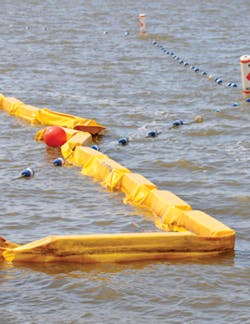Turbidity Curtains Aid Cleanup of Boston Harbor
Airplane Safety and Aquatic Protection
Any work taking place in and around Boston Harbor attracts a lot of attention from local, state, and federal agencies. As a result, when the Massachusetts Port Authority (Massport) came to the realization that runway safety area work at Boston’s Logan International Airport was necessary to meet required guidelines by 2015, it began discussion with federal authorities as early as 2007.
“As part of the permitting process, Massport committed to a double turbidity curtain,” said Derek Hanson. “So that’s what we put in. We have a double line of turbidity curtains set up.”
Logan Airport sticks out into Boston Harbor, and it was necessary to extend the length of one of the airport’s runways, but the existing runway ended pretty much at the water’s edge. Building a standard runway deck into the harbor would have required massive amounts of backfill, damaging the sensitive aquatic environment.
“Over the past 20 years, there has been a huge push to clean up the harbor,” says Hanson, site superintendent with McCourt Construction. “The goal was to turn it from a pretty polluted, pretty industrial setting to relatively clean water. Now it’s gone to the point of actually being very clean water.”
Hanson’s company is involved with overhauling the runway safety area on one of the runways at the airport. Because of the sensitive environment of Boston Harbor, Massport was insistent on minimizing silt and sediment movement during the extensive runway safety area work.
“The area we’re transitioning into the water is about 500 feet wide, and it extends on average about 150 feet into the water, from the high tide line down to the average low tide line.” Says Hanson. “This is an average. It’s more at the sides—it’s almost 200 feet. But at the very center of the area, it may only be 100 feet or so. The average tide drop in this area is about 10 to 10.5 feet, so the water level drops considerably, and it goes out a long way.”
“Every 12.5 hours or so we make a full cycle, from low tide all the way back up to high tide. The inner curtain is 800 feet long, and it transitions from landside, where it is anchored, over a length of 150 feet, from zero feet deep to 10 feet deep. What would be the front edge, where it is 10 feet deep, turns and over the course of 150 feet again transitions back from 10 feet deep to zero.
“We’re encompassing the end of the area, the end of the runway, in a three-sided pattern. The outer barrier is 850 feet long. Across the outer end, there’s an additional 50 feet of that 10-foot-deep curtain.”
Hanson notes that by design, there is considerable movement of the turbidity curtains.
“This system has an encapsulated float at the top, so it travels up and down with the tide. As the tide goes out, the turbidity barrier is more or less sitting on the ground. Then when the tide comes back up, the turbidity curtain rises up and actually, at high tide, the curtain pulls away from the bottom of the water by about a foot.
“The idea of that is that any silt that has accumulated on the turbidity curtain itself gets washed off. Otherwise, the turbidity curtain would get weighed down by the amount of silt that is being captured on it. Eventually it would sink and not return to the top. So every 12 hours, basically it washes itself and returns to a relatively clean condition.”
Hanson reports that this double turbidity curtain has worked nearly to perfection.
“Now that we have this thing set up, we’ve never seen any turbidity migrate outside of that inner curtain. The outer curtain has really been there as a backup. It’s been an effective system.
“You can see the silt in the water, and we don’t really get anything migrating outside of this curtain. It contains everything. When the tide then goes out, that sediment settles back down to the ground, and when the tide water comes back in, the water is basically back to being clean again.”
One of the issues that has come up is that in the tidal environment, the water and the curtains are changing direction; they’re being moved up and down, and pulled in and out, so there is a lot of tugging on the barrier.
“We’ve had to relocate the barrier curtains a couple of times,” explains Hanson. “We have to get out there in a boat and tug it back in, because it collects and filters so much water that it acts as a big sail in the tide. Spilldam Environmental, manufacturer of the curtains, has been fantastic to deal with. We consulted with them about this issue.”
He notes that the curtains are secured by 40 anchors and also with concrete blocks, similar to traffic barriers. “But even with all those anchorage points, it continues to pull itself all around. So we’ve had to adjust the location of this several times. The wave action and the force of the tide water moving in and out keep moving the turbidity curtains all over the place. So we’ve had to relocate this barrier several times.”
Because of the heavy equipment being used on the job, Hanson has had to be cautious about equipment fueling and the location of his vehicles.
“We had to establish a 100-foot buffer zone, which is 100 feet back from the high-water mark. Any equipment that isn’t being used—pickup trucks, delivery vehicles, and so on—has to be parked outside that 100-foot buffer area. We’re not allowed to leave any equipment within that zone.”
A variety of other BMPs were also employed at the work site.
“We’ve had silt fence, and we’ve used hay bales and straw wattles. These encompass the entire perimeter of the job, including our equipment storage area outside that 100-foot buffer. We also have two catch basins in the area, drainage points that are outside of our turbidity curtain, and those are protected with silt fence.”
Hanson spoke highly of his turbidity curtain supplier, Spilldam Environmental. “They are a local company, and the owner of the company has done work at Logan Airport before, so he was familiar with the airport. Because of their location, they were able to deliver quickly. We had this curtain custom made, and we had it within two weeks of our order.
“The product is a Cadillac of turbidity curtains as far as this work is concerned. We’re very impressed with how well it is made, how quickly they were able to get it delivered to us, and, most importantly, how effective it is. You wouldn’t think that this curtain hanging down would have that effect, but it is nearly 100% effective.”
Another group that is especially pleased with the project is the local seagull population.
“We have found that it is trapping all kinds of small crabs inside the curtain,” says Hanson. “As they try to migrate out, they get caught up in the curtain, so the seagulls have a feast every day when the water drops down, because now they have all these crabs trapped on the surface. It’s been detrimental to the crab population in this local area, but the seagulls are having a field day. They love it.”


